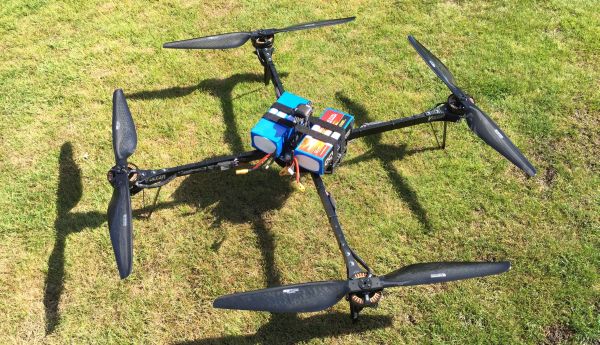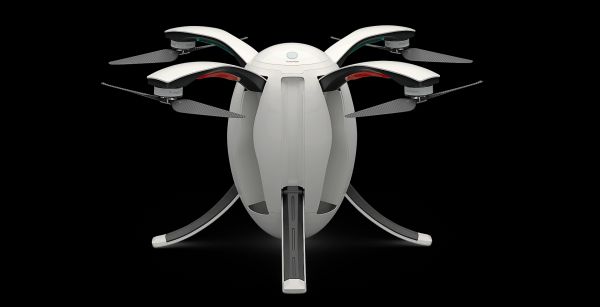Podcast: Play in new window | Download (Duration: 36:03 — 20.7MB)
Subscribe: Email |
sUAS and the proposed FAA reauthorization bill, ALPA proposes to lock sUAS, a universal UAV control interface, Amazon Prime Air testing outside the US, and EASA drone rules.
News
Representative Bill Shuster of Pennsylvania, the chairman of the House Transportation and Infrastructure Committee, introduced the Aviation Innovation, Reform, and Reauthorization Act of 2016 (the “AIRR” Act, or H.R. 4441) [PDF] to Congress February 3, 2016.
Here’s a summary of some of the key elements of the Act, under Title IV Safety, Subtitle B – Unmanned Aircraft Systems:
Sec. 432. Codification of existing law; additional provisions.
The term “model aircraft” means an unmanned aircraft that is (A) capable of sustained flight in the atmosphere; (B) flown within visual line of sight of the person operating the aircraft; and (C) flown for hobby or recreational purposes.
Special rules for model aircraft:
(a) …the FAA may not promulgate any rule or regulation regarding a model aircraft, or an aircraft being developed as a model aircraft, if
(1) the aircraft is flown strictly for hobby or recreational use;
(2) the aircraft is operated in accordance with a community-based set of safety guidelines and within the programming of a community-based organization;
(3) the aircraft is limited to not more than 55 pounds unless otherwise certified through a design, construction, inspection, flight test, and operational safety program administered by a community-based organization;
(4) the aircraft is operated in a manner that does not interfere with and gives way to any manned aircraft; and
(5) when flown within 5 miles of an airport, the operator of the aircraft provides the airport operator and the airport air traffic control tower… with prior notice of the operation (model aircraft operators flying from a permanent location within 5 miles of an airport should establish a mutually agreed upon operating procedure with the airport operator and the airport air traffic control tower…)
(b) A flight of an unmanned aircraft shall be treated as a flight of a model aircraft… (regardless of any compensation, reimbursement, or other consideration exchanged or incidental economic benefit gained in the course of planning, operating, or supervising the flight), if the flight is
(1) conducted for instructional or educational purposes; and
(2) operated or supervised by an eligible not-for-profit organization.
(c) Nothing… may be construed to limit the authority of the Administrator to pursue enforcement action against persons operating model aircraft who endanger the safety of the national airspace system.
Sec. 434. Unmanned aircraft systems senior leadership and staffing.
The Administrator shall designate a sufficient number of safety inspectors to focus on the safety oversight of unmanned aircraft systems into the national airspace system…
Sec. 435. Sense of Congress regarding unmanned aircraft safety.
The FAA should pursue all available civil and administrative remedies available to the Administrator, including referrals to other government agencies for criminal investigations, with respect to persons who operate unmanned aircraft in an unauthorized manner; the Administrator should place particular priority on continuing measures, including partnerships with nongovernmental organizations, to educate the public about the dangers to the public safety of operating unmanned aircraft near airports without the appropriate approvals or authorizations; and manufacturers and retail sellers of small unmanned aircraft systems should take steps to educate consumers about the safe and lawful operation of such systems.
Sec. 438. Facilitating unmanned aircraft authorization in support of fire fighting operations.
The FAA shall enter into agreements with the Secretary of the Interior and the Secretary of Agriculture as necessary to continue the expeditious authorization of safe unmanned aircraft system operations in support of fire fighting operations…
Sec. 439. Low altitude unmanned aircraft system traffic management.
The FAA shall establish an advisory committee comprised of government representatives and appropriate industry representatives to:
(1) assess the necessity, feasibility, and benefits of establishing unmanned aircraft traffic management systems for airspace between the surface and 400 feet above ground level;
(2) develop recommendations for government oversight of such systems; and
(3) address any other issues the advisory panel considers necessary and appropriate.
The committee report is due in one year.
Sec. 440. UAS detection systems pilot program.
The FAA will establish a pilot program to deploy and evaluate the effectiveness of unmanned aircraft detection systems in maintaining the safety of air commerce and navigable airspace in light of aviation safety hazards posed by unauthorized operations of unmanned aircraft in proximity to airports. Three airports are to be chosen for pilot program, with the report due in 18 months.
Sec. 441. Evaluation of aircraft registration for small unmanned aircraft.
Within 180 days, the FAA shall develop and track metrics to assess compliance with and effectiveness of the registration of small unmanned aircraft systems by the FAA… including metrics with respect to
(1) the levels of compliance…
(2) the number of enforcement actions taken by the Administration for violations of or noncompliance… together with a description of the actions; and
(3) the effect of the [rule] on compliance with any fees associated with the use of small unmanned aircraft systems.
Air Line Pilots Association (ALPA) president Tim Canoll wants the FAA reauthorization legislation to require that sUAS operators must enter a “key code” before the UAV will fly. To obtain a key code, UAV owners would have to pass an online training course. Canoll said, “I’d like [UAV manufacturers] to voluntarily do it, but I believe if we could mandate it, it would take a lot of pressure off them.”
The US Army is developing a universal UAS control interface that would allow operators to fly different UAV types with the same controls. Currently, UAS types each have their own controls, and operators are trained to fly a specific type.
Amazon CEO Jeff Bezos says the company is testing drones for Amazon Prime Air in Canada, the United Kingdom, and now the Netherlands. Significant FAA restrictions on flying in the U.S. are driving commercial operators like Amazon out of the U.S. to develop their technology.
Speaking of the Netherlands, law enforcement in that country is looking at using eagles to grab rogue drones.
The European Aviation Safety Agency (EASA) released a revised UAS regulation technical opinion in December. Head of operations at Resource Group – Unmanned Aviation Services, Neil Williams, believes the EASA proposal is too liberal.
Flightglobal reports that “The ‘open’ category proposed by EASA would allow for users to operate UAVs weighing 25kg (55lb) or less for whatever purpose, so long as ‘safety is ensured through compliance with operational limitations, mass limitations as a proxy of energy, product safety requirements, and a minimum set of operational rules.’”.
Williams worries that EASA focuses on UAV size, weight, and kinetic energy. Other factors that impact safety like training and insurance are not considered.
Resource Group – Unmanned Aviation Services is accredited by the UK CAA to assess for pilot competency for drones of 20Kgs or below, and verify that organisations meet the UK CAA requirement for Permissions For Aerial Work (PFAW).
The Federal Aviation Administration launched a public service announcement, including a 20-second The Super Bowl is a No Drone Zone video, to let people know the airspace around Levi’s Stadium is a No Drone Zone during the Super Bowl.
TFRs will prohibit certain aircraft operations, including unmanned aircraft operations, within a 32-mile radius of the stadium in Santa Clara, California on game day. The restrictions will be in effect from 2 p.m. to 11:59 p.m. on Sunday, Feb. 7, 2016.
Video of the Week
You’ve heard of kiteboarding? Welcome to droneboarding.
 The House FAA reauthorization bill returns to Committee, package delivery by drone in Singapore, a quadcopter crosses the English Channel, filming wildlife with drones, a drone detection system for airports, and putting UAVs on the internet.
The House FAA reauthorization bill returns to Committee, package delivery by drone in Singapore, a quadcopter crosses the English Channel, filming wildlife with drones, a drone detection system for airports, and putting UAVs on the internet.

 Jonathan Rupprecht is a commercial pilot with single and multi-engine aircraft ratings and also a flight instructor. He has a Bachelor of Science in Professional Aeronautics from Embry-Riddle Aeronautical University, and his law degree from Florida International University School of Law.
Jonathan Rupprecht is a commercial pilot with single and multi-engine aircraft ratings and also a flight instructor. He has a Bachelor of Science in Professional Aeronautics from Embry-Riddle Aeronautical University, and his law degree from Florida International University School of Law.